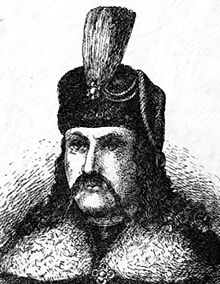Višeslav I
| Višeslav | |
|---|---|
| Prince of Serbia | |
 |
|
| Prince of Serbia | |
| Reign | c. 780–? |
| Predecessor | Unnamed |
| Successor | Radoslav |
| Born | 8th century |
| Issue | Radoslav |
| Dynasty | Vlastimirović (progenitor) |
| Religion | Slavic |
Višeslav (Greek: Βοϊσέσθλαβος, Serbian: Вишеслав) or Vojislav (Војислав) is the first Serbian ruler known by name, who ruled in c. 780. Serbia was a Slavic principality, subject to the Byzantine Empire, located in the western Balkans, bordering with Bulgaria in the east. Mentioned in the De Administrando Imperio (DAI) from the mid-10th century, Višeslav was a progenitor of the Serbian ruling family, known in historiography as the Vlastimirović dynasty. He descended from "the Serbian prince" who led his people to the Dalmatia province and established hereditary rule under Byzantine suzerainty. The names of Višeslav's predecessors were not included in the DAI. The dynasty ruled the Serbian Principality from the early 7th century until c. 960.
The history of the early medieval Serbian Principality and the Vlastimirović dynasty is recorded in the work De Administrando Imperio ("On the Governance of the Empire", DAI), compiled by the Byzantine Emperor Constantine VII Porphyrogenitus (r. 913–959). The DAI drew information on the Serbs from, among others, a Serbian source. The work mentions the first Serbian ruler, who is without a name but known conventionally as the "Unknown Archon", who led the Serbs from the north to the Balkans. He received the protection of Emperor Heraclius (r. 610–641), and was said to have died long before the Bulgar invasion of 680. Slavs invaded and settled the Balkans in the 6th and 7th centuries. Porphyrogenitus stressed that the Serbs had always been under Imperial rule. His account on the first Christianization of the Serbs can be dated to 632–638; this might have been Porphyrogenitus' construction, or may have really taken place, encompassing a limited group of chiefs and then very poorly received by the wider layers of the tribe.
...
Wikipedia
